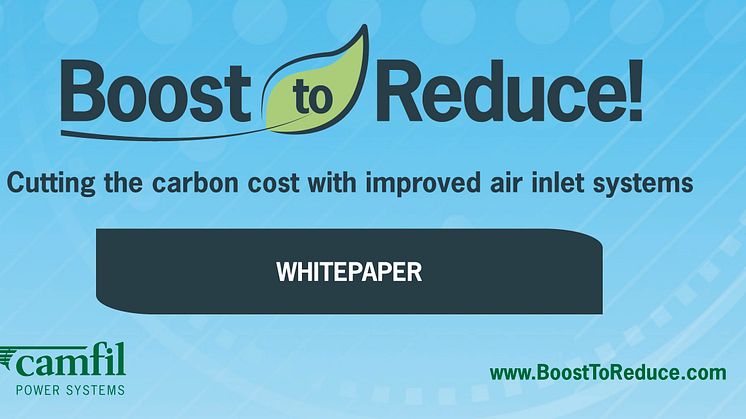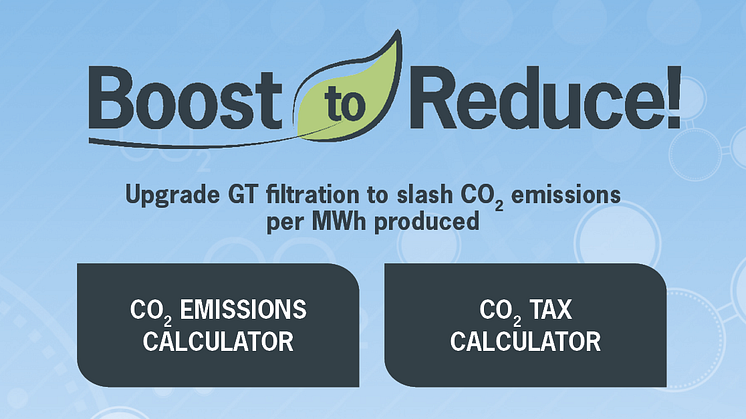
Blog post -
Cutting the carbon cost with improved air inlet systems
The push for going green
As the world becomes environmentally conscious, the Power Generation and Oil and Gas industries have seen mounting pressure to find greener solutions. Governments across the world have pledged themselves towards making an environment friendly future. Policy changes have seen the introduction of carbon taxes and stricter regulations being imposed across multiple industries. The green image that a company holds has become significantly more important, with investors favoring those who commit themselves to meaningful change. With a growing demand for greener practices and rising operational costs, it has become imperative for gas turbine operators to cut their carbon footprints, reduce operational costs, and become more efficient.
The source of carbon
When fuel is burned in a combustion reaction to produce energy, carbon dioxide is released as a byproduct. A fixed amount of carbon is emitted per unit of fuel burned, with more than 2 kg of CO2 released for every 1 kg of natural gas burned. Carbon intensity is used to measure how much CO2 is emitted per MWh produced, while heat rate measures the ratio of fuel burned per MWh produced. Changes to an engine’s carbon intensity are directly proportional to those of it’s heat rate, therefore it is crucial to keep a stable heat rate in order to reduce environmental impact.
Cutting the carbon
Upgrading the air intake system of a plant is one of the easiest, most cost-effective ways to reduce its carbon footprint. There are three properties that allow for filters to reduce carbon impact; high EPA efficiency rating according to the EN1822:2009 standard, low and stable pressure drop, and hydrophobic media. High efficiency EPA filters are designed to eliminate the effects of contaminant bypass such as fouling, erosion and corrosion, which can drastically impact the heat rate of an engine. Filters that deliver a lower stable pressure drop over time also reduce carbon intensity, since even a 1” increase in pressure drop will raise the heat rate of a simple cycle engine by 0.125%. Hydrophobic filters prevent water soluble contaminants from reaching the engine, while design features such as vertical pleating with interrupted hot melt separators allow water to drain rather than collect within the media and cause pressure spikes. All three properties combine to reduce carbon impact while improving availability and providing engine protection.
Table 1 below highlights the impact that different filter grades have on carbon emissions. A filter combination of a G4 prefilter (as per EN779:2012) and an M6 final filter (as per EN779:2012) were used as a benchmark comparison to a selection of higher efficiency, hydrophobic filter combinations.

Assumptions:
Heat rate: 8 600 MJ/MWh; Operating hours: 8 000 h; Power output: 200 MW; Part load application; The average car travels roughly 20 000 km a year, and follows the European Environment Agency 2020 target for vehicular carbon emissions of 95g CO2/km.
It is immediately apparent that by increasing filter efficiency, the carbon savings gained are equivalent to taking about 8 000 - 18 000 cars off the road! In order to reduce carbon impact in the long term, filters must be highly efficient, hydrophobic, and must be able to maintain a low and stable pressure drop. The E10 and E12 filters shown in this example include all three features, which work collectively to reduce carbon impact.
The effects of fouling on gas turbine carbon emissions
Optimized filtration solutions are designed to protect the turbine from all environments and operating conditions, reducing the rate of fouling on the turbine blades. Fouling has several negative effects on a turbine, decreasing the maximum power output capacity while increasing the heat rate of the engine. The drop in power capacity is generally twice as large as the increase in heat rate due to fouling. An example of this can be seen in Figure 1, where the output capacity of a turbine falls by 10% while heat rate increases by 5%. A higher heat rate means that the carbon intensity of the engine will also increase, leading to more carbon emissions per MWh in both part load and base load applications.
Figure 1: The impact of fouling on base load vs part load operation
 Part load
Part load
Part load engines do not operate at their maximum capacity, but rather at a lower stable capacity. This means that the reduction in power capacity due to fouling will not immediately stop a part load turbine from running at operational load level. This is why the direct power output of an engine is not always affected by fouling in part load applications, as shown in Figure 1. However, the increase in heat rate means that fouled part load engines consume additional fuel to maintain their power output, leading to increased fuel costs, more carbon emissions, and higher CO2 intensity.
Base load
For a base load power plant, which does operate at full capacity, a reduction in maximum rated power output leads to less power being generated and thus less fuel being burned. Fuel costs and associated carbon taxes decrease, making it appear cheaper to operate the turbine. However, the increase in heat rate means that a fouled engine burns with a higher carbon intensity than a clean turbine. Furthermore, the loss in power output will cut revenue for the plant and cause a deficiency within the energy grid, decreasing the profitability of operations.
Table 2 below reports that since a fouled engine is unable to satisfy base load demand for energy production, it becomes necessary to find additional sources of energy. In this case, it is not recommended to fire a turbine at higher temperatures to produce more power since it would reduce the lifetime of engine components. Therefore energy demand can either be supplemented directly through the operation of additional unfouled turbines, or indirectly through a third party. Although the direct carbon emissions of the fouled engine appear to be lower, the indirect carbon emissions required to uphold stable energy production reveal that the total carbon emissions of a base load engine are higher when fouled.
Table 2: Comparing the carbon emissions of base load engines when clean vs fouled
 Assumptions:
Assumptions:
Supplemented indirect power provided by a clean engine. Emissions were calculated as follows:
Power demand (MW) * Carbon intensity (kg CO2 per MWh) * 8000 hours per year * 10 -3 tonnes per kg = Carbon emissions (tonnes of CO2 per year)
Why choose better air inlet systems?
Other methods of reducing an engine’s CO2 intensity do exist. These include carbon scrubbing, post-combustion carbon capture, and pre-combustion carbon capture. However, these methods require additional infrastructure to be built which often leads to higher maintenance and operational costs. The gas turbine itself could also be upgraded to a more efficient version, but this requires a great capital expenditure as well.
Since air filters are already required for the nominal operation of gas turbines, upgrading the air inlet systems generally involves the usage of pre-existing infrastructure or an upgrade of the current system. In either case, the capital expenditure results in a high savings to investment ratio. Operational expenses and carbon taxes are greatly reduced, while negative effects such as fouling, erosion, and corrosion are minimized. This extends the lifetime of engine components, and increases availability and reliability by reducing the frequency of offline and online washes.
In short, not only do improved air inlet systems reduce the CO2 intensity of your operations, but they also protect and improve engine performance, meaning that more can be gained from the engine at a lower environmental cost. It is cost-effective, easy and one of the most accessible solutions to cut the CO2 intensity of your gas turbines.
Additional performance benefits
Turbine degradation and unstable pressure drop can also be mitigated by using hydrophobic, low pressure drop, EPA filters. Some of the advantages include:
- Increased profitability from fuel efficiency
- Increased availability for energy production
- Extended turbine part life
- Extended filter life
- Increased engine reliability
- Increased safety
Visit BoostToReduce.com and calculate your potential savings!



